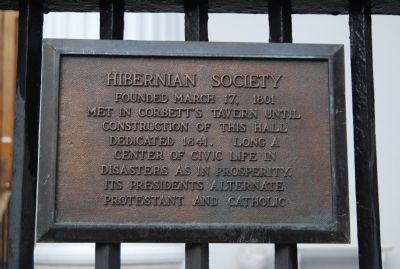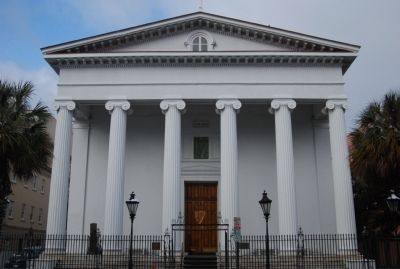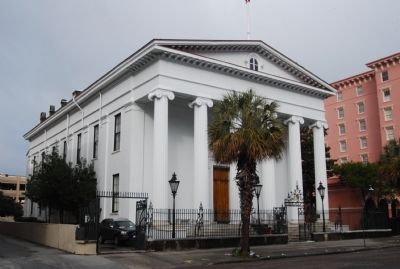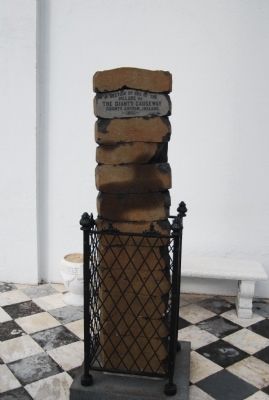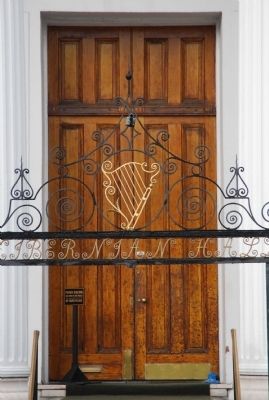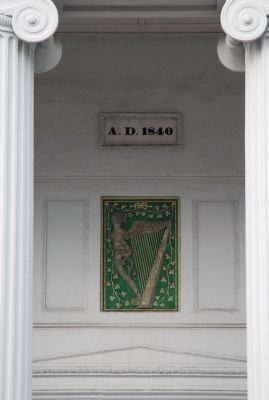French Quarter in Charleston in Charleston County, South Carolina — The American South (South Atlantic)
Hibernian Hall
Founded March 17, 1801
Met in Corbett's Tavern until construction of this hall dedicated 1841. Long a civic life in disasters as in prosperity. Its presidents alternate Protestant and Catholic.
Topics and series. This historical marker is listed in these topic lists: Fraternal or Sororal Organizations • Notable Buildings. In addition, it is included in the National Historic Landmarks series list. A significant historical date for this entry is March 17, 1854.
Location. 32° 46.644′ N, 79° 55.878′ W. Marker is in Charleston, South Carolina, in Charleston County. It is in the French Quarter. Marker is at the intersection of Meeting Street and Chalmers Street, on the left when traveling north on Meeting Street. Touch for map. Marker is at or near this postal address: 105 Meeting Street, Charleston SC 29401, United States of America. Touch for directions.
Other nearby markers. At least 8 other markers are within walking distance of this marker. Fireproof Building (within shouting distance of this marker); Quaker Burial Ground (within shouting distance of this marker); a different marker also named Fireproof Building (within shouting distance of this marker); Lucius Mendel Rivers (within shouting distance of this marker); County of Charleston Historic Courthouse (within shouting distance of this marker); Elizabeth Hutchinson Jackson (within shouting distance of this marker); George Washington Statue (within shouting distance of this marker); Blake Tenements (about 300 feet away, measured in a direct line). Touch for a list and map of all markers in Charleston.
Also see . . .
1. South Carolina Department of Archives and History. (Submitted on February 13, 2010, by Michael Sean Nix of Spartanburg, South Carolina.)
2. Charleston Hibernian Hall. Site contains old photo of Hibernian Hall (Submitted on February 13, 2010, by Michael Sean Nix of Spartanburg, South Carolina.)
Additional commentary.
1. Hibernian Hall
Hibernian Hall, a National Historic Landmark, was built in 1840 to provide a meeting place for the Hibernian Society, an Irish benevolent organization founded in 1801. The Hall is the only extant building associated with the National Democratic Convention of 1860, one of the most critical political assemblies in this nation's history. Hibernian Hall served as the convention headquarters for the faction supporting Stephen A. Douglas. It was hoped that Douglas would bridge the gap between the northern and southern delegates on the issue of extending slavery to the territories. The first floor of the Hall was used for meetings, while the second floor was filled with hundreds of cots for the delegates. The convention disintegrated no candidate was able to summon a two-thirds majority vote. This divisiveness resulted in a split in the Democratic party, and the election of Abraham Lincoln, the Republican candidate.
Hibernian Hall was the first semi-public building of pure Greek style to be built in the city, and the only building in Charleston designed by architect Thomas U. Walter of Philadelphia. Walter's design included an Ionic pediment which collapsed in the earthquake of 1886 and was replaced by a Corinthian pediment with brackets and a center circular-arched window. The dignified exterior of the Hall does not allude to the flamboyant ballroom and double stairhall within. The Irish harp carved in the panel above the main door and within the iron gates, as well as a stone from Ireland's Giant's Causeway, reflect the ethnic heritage of the Hall's founders. Christopher Werner, one of Charleston's foremost ironworkers, is responsible for the Hall's gates.
The Hibernian Society continues to meet regularly, holding annual elections, alternating each year between a Roman Catholic and Protestant president. The Hall still serves as the location for many events, including an annual St. Patrick's Day celebration, society balls and other brilliant social occasions.
(Article from the National Parks service site.)
— Submitted February 13, 2010, by Michael Sean Nix of Spartanburg, South Carolina.
2. National Register of Historic Places:
Hibernian Hall *** (added 1973 - Building - #73001686) •
105 Meeting St., Charleston •
Historic Significance: Event •
Area of Significance: Politics/Government •
Period of Significance: 1850-1874 •
Owner: Private •
Historic Function: Social •
Historic Sub-function: Meeting Hall
Current Function: Social •
Current Sub-function: Clubhouse •
— Submitted January 13, 2011.
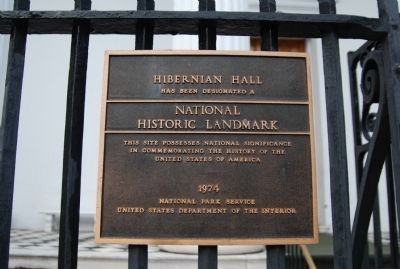
Photographed By Michael Sean Nix, February 13, 2010
4. Hibernian Hall Plaque
has been designated a
National Historic Landmark
This site possesses National significance in commemorating the history of the united States of America
1974
National Park Service United States Department of the Interior
Credits. This page was last revised on February 16, 2023. It was originally submitted on February 13, 2010, by Michael Sean Nix of Spartanburg, South Carolina. This page has been viewed 1,422 times since then and 55 times this year. Photos: 1, 2, 3, 4, 5, 6, 7. submitted on February 13, 2010, by Michael Sean Nix of Spartanburg, South Carolina. • Bill Pfingsten was the editor who published this page.
